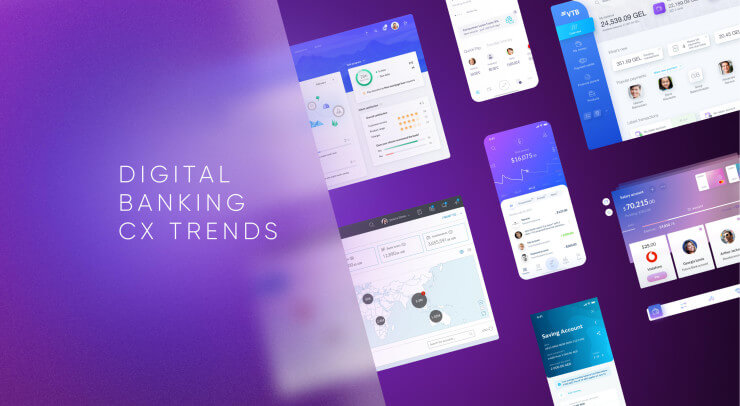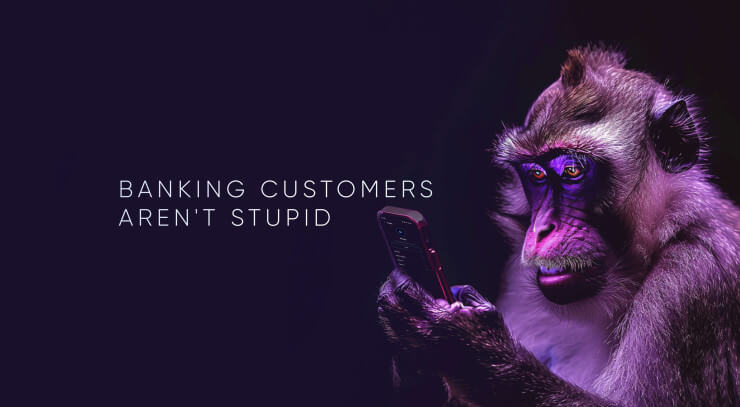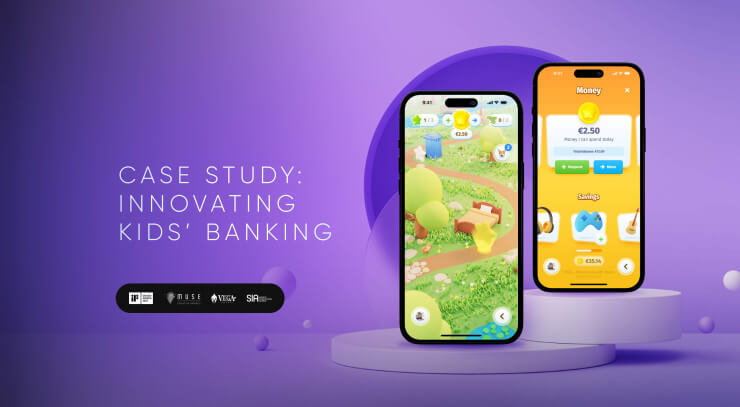Customers demand seamless, intuitive and personalized banking experiences (72% customers said personalization is “highly important,” and 77% banking leaders said it leads to increased customer retention). Yet, financial institutions often find themselves mired in outdated systems, stringent regulations, copycat interfaces and rising cybersecurity threats. This article delves into the tension between the urgent need for next-gen, customer-centered financial products and the significant hurdles financial brands must overcome to deliver them.
It is clear there is an urgent need for next-gen digital banking products. A survey from Chase found 62% of consumers said they can’t live without their mobile banking app, and 78% are using it weekly. But despite significant advancements, many digital banking platforms still offer clunky and non-intuitive user interfaces.
Cisco AppDynamics global research shows that 68% of 13,000 global consumers find poor digital experiences disrespectful, and their expectations of digital services have increased. Fifty-seven percent give brands only one shot to impress, but 60% blame the app and brand when they encounter a problem with their digital service.
McKinsey banking survey found that while Fintechs and neobanks release new product features every two to four weeks on average, traditional banks have product rollout cycles of four to six months. Moreover, the average age of universal bank IT applications is 14 years compared to three years in digital banks.
Many banks operate with fragmented digital ecosystems, where services are not well integrated. This results in a disjointed customer experience, with users needing to navigate multiple platforms for different services.
Customers now expect seamless, personalized and integrated digital experiences. With 73% of the world’s interactions with banks now taking place digitally, financial companies must exceed these expectations to retain and attract customers.
Fintech companies and big tech firms are raising the bar with innovative, user-friendly and highly personalized digital services. For example, 41 percent of retail consumers surveyed by McKinsey in 2021 said they plan to increase their Fintech product exposure.
Emerging technologies, such as AI, ML and blockchain, are revolutionizing financial services. Banks need to harness these technologies to offer real-time, predictive and secure banking experiences. McKinsey estimates generative AI alone will deliver value equal to an additional $200 billion to $340 billion annually.
Digital Excellence Challenges Finance
Digital excellence is a critical differentiator for any modern business, defined as the best use of digital systems and products to achieve the strategic goal of thriving in the digital age. It can help financial brands quickly adapt to market changes, emerging technologies and rising consumer expectations. This flexibility is crucial for responding to new regulatory requirements, changing customer preferences and technological advancements. The need for digital excellence in finance is obvious, but the following hurdles need to be overcome:
Customer Experience
One of the biggest challenges is to provide a seamless customer experience due to diverse user needs, inconsistent interfaces across devices and rapidly evolving technology. Complex, unattractive and non-intuitive financial service interfaces result in customer dissatisfaction and potential loss of customers.
Digital excellence in modern banking translates to delivering a seamless, intuitive and engaging customer experience across all digital touchpoints. It means providing a user-friendly interface, personalized services and quick, reliable transactions that meet the evolving expectations of tech-savvy consumers.
- Ensure user-friendly interfaces with simplified navigation and visually appealing design that make banking easy and enjoyable.
- Provide tailored services and recommendations based on user data and behavior.
- Ensure that your services are available on various devices, including mobile phones, tablets and desktops.
Operational Efficiency
Financial institutions face inefficiencies due to outdated legacy systems, scalability issues and the slow transition to automation. These inefficiencies lead to increased operational costs, higher error rates and slower service delivery, impacting overall customer satisfaction and profitability.
Achieving digital excellence involves automating routine processes, leveraging AI for customer support and implementing robust cybersecurity measures. This enhances operational efficiency, reduces costs and minimizes human error.
- Use technology to streamline processes like loan approvals, account management and customer service.
- Provide instant support and resolving customer queries through intelligent automation.
- Implement advanced security protocols to protect user data and transactions.
Data-Driven Decision Making
The financial industry often fails to fully leverage data for decision-making due to poor data quality, fragmented data sources and slow real-time processing capabilities. This hampers the ability to gain actionable insights, forecast trends accurately and make timely decisions, resulting in missed opportunities and suboptimal service offerings.
Modern banking services must harness the power of big data and analytics to make informed decisions. This involves analyzing customer behavior, transaction patterns and market trends to offer better services and products.
- Use data analytics to understand customer needs and preferences.
- Forecast trends and customer behavior to tailor offerings.
- Make immediate decisions based on current data for enhanced service delivery.
Innovation and Adaptability
Financial institutions struggle to stay competitive due to slow adoption of Fintech partnerships, difficulty integrating new technologies and navigating complex regulatory landscapes. This lack of innovation and adaptability hinders their ability to offer cutting-edge financial services, leading to a competitive disadvantage.
Digital excellence means staying ahead of the curve by adopting the latest technologies and continuously improving digital offerings. This includes integrating Fintech solutions, blockchain technology and open banking to provide innovative financial services.
- Collaborate with Fintech companies to offer innovative services.
- Ensure transparency and security in transactions.
- Allow third-party developers to build services around your financial service, fostering innovation and competition.
Accessibility
The financial industry often overlooks the need for accessible digital services, leading to non-compliance with accessibility standards and exclusion of users with diverse abilities. This results in a significant portion of the population being underserved, regulatory penalties and damage to the institution's reputation.
Ensuring that banking services are accessible to everyone is a crucial aspect of digital excellence. This means designing interfaces that are usable by people with diverse abilities and ensuring compliance with accessibility standards. By making banking inclusive, financial institutions not only meet regulatory requirements but also broaden their customer base and improve user satisfaction.
- Incorporate accessibility features, such as screen readers, voice commands and adaptable text sizes.
- Adhere to accessibility standards like the Web Content Accessibility Guidelines (WCAG). Conduct accessibility testing with users who have disabilities to identify and address potential issues.
- Regularly update and improve accessibility features based on user feedback and technological advancements.
10 UX Design Steps to Ensure Digital Excellence in Finance
Creating an exceptional digital banking experience requires understanding both user needs and the evolving landscape of financial technology. Here’s a streamlined guide to achieving digital excellence in digital services:
Step 1: Align Digital Service Strategy with Business Strategy
The foundation of creating a successful digital banking experience lies in aligning the digital service strategy with the overall business strategy. This ensures that the digital initiatives are not only technologically sound but also support the broader goals of the organization, driving both innovation and business growth.
Key Actions:
- Conduct a thorough market analysis to understand industry trends, competitive landscape, best practices and areas for differentiation.
- Thoroughly understand the digital service role in achieving the key business objectives and goals and align it with business priorities.
- Ensure mutual synchronization among stakeholders on required digital initiatives and allocate resources, including budget, technology and talent, to support the digital service strategy.
Step 2: Know Your Users and Build Empathy
Understanding your users is the foundation of any successful digital banking initiative. Identify your target audience by creating user personas through surveys, interviews and data analysis. Develop empathy maps for your personas to gain insights into their emotional journey.
Key Actions:
- Conduct user research through surveys and interviews to create detailed personas that represent your key user groups.
- Create an empathy map that demonstrates their pain points, preferences and financial habits.
- Use these insights to guide your digital service design decisions.
Step 3: Map the User Journey
Create a detailed Customer Journey Map (CJM) to understand how users interact with your digital service at each stage. This map should highlight critical touchpoints and user emotions throughout their journey.
Key Actions:
- Develop a Customer Journey Map covering all stages of user interaction.
- Identify key touchpoints and potential pain points.
- Align business objectives with user needs to ensure a seamless experience.
Step 4: Align Conceptual and Mental Models
Ensure that your conceptual service model aligns with users' mental models. This means designing the user interface structure and navigation in a way that feels intuitive and familiar to users.
Key Actions:
- Conduct card sorting exercises to understand how users categorize information.
- Design a simple and intuitive information architecture.
- Focus on minimizing cognitive load and simplifying navigation.
Step 5: Develop User Flows
Transform user scenarios into detailed user flows that outline the steps users take to complete key tasks. This helps in creating a logical and efficient interaction sequence.
Key Actions:
- Create Low Fidelity (LoFi) user flow maps to outline essential user scenarios.
- Validate these flows through user testing and feedback.
- Adjust and refine user flows based on insights.
Step 6: Design Detailed Wireframes
Create High Fidelity (HiFi) wireframes to visualize the interface layout and interactions. Wireframes should be tested to ensure they meet user expectations and are easy to navigate.
Key Actions:
- Develop HiFi wireframes for critical screens and interactions.
- Conduct usability testing to identify any issues.
- Iterate on the design based on user feedback.
Step 7: Establish a Key Design Concept
Create a visual language and style that align with your brand’s identity while evoking the proper emotions. Design a comprehensive design concept that sets the visual and functional standards for the digital service.
Key Actions:
- Create a mood board to define the visual direction.
- Define a key design concept that integrates UX and UI elements.
- Ensure the concept is aligned with the latest design trends and standards and resonates with your customers.
Step 8: Design UI for User Flows and Screens
This step involves translating the conceptual design into tangible visual elements that users will interact with directly across all user scenarios. The goal is to ensure the interface is not only aesthetically pleasing but also functional and intuitive.
Key Actions:
- Incorporate design principles that enhance usability and ensure that the interface adheres to accessibility standards.
- Ensure a user interface that creates a predictable and familiar user experience.
- Ensure visual consistency across all screens and touchpoints.
Step 9: Prototype and Test
Build interactive prototypes to test the service functionality and design. Use these prototypes to gather user feedback and make necessary adjustments before final development.
Key Actions:
- Create interactive prototypes using tools like Figma.
- Conduct user testing sessions to gather feedback.
- Iterate on the prototype based on testing results.
Step 10: Implement a Design System
Develop a comprehensive design system to ensure consistency and scalability. A design system acts as a blueprint for developers and designers, ensuring a cohesive user experience across all digital touchpoints.
Key Actions:
- Create a UX/UI design system that incorporates UX strategy and UI components, style guides and design principles.
- Ensure the system is easily accessible and usable by all team members.
- Regularly update the design system to incorporate new insights and trends.
Conclusion
Financial institutions need digital excellence to thrive. Customers demand a seamless and personalized experience, while Fintech and new technologies are disrupting the industry. By embracing digital excellence with no compromises, financial brands can provide an intuitive user interface, gain valuable customer insights, automate processes and offer innovative financial services, all of which lead to increased customer satisfaction and a competitive edge.
Achieving digital excellence in next-gen banking involves more than simply adopting the latest technologies or mimicking successful Fintech innovations. It's about creating a holistic, user-centric approach that prioritizes seamless, intuitive and personalized experiences for customers. Financial institutions must transcend the superficial adoption of digital trends and commit to genuine innovation that addresses the unique needs and expectations of their users.
The journey toward digital excellence requires overcoming significant challenges ─ from outdated legacy systems to fragmented digital ecosystems. It demands a strategic transformation that integrates emerging technologies like AI, ML and blockchain to deliver real-time, predictive and secure banking services. This transformation is essential not only for operational efficiency but also for enhancing customer satisfaction and loyalty.
Next-gen financial brands need a dedicated focus on user experience, operational efficiency, data-driven decision-making and relentless innovation. By moving beyond a copycat approach and truly understanding and addressing the needs of their customers, financial institutions can create digital banking experiences that are not only functional but also delightful and engaging. This holistic approach will not only retain existing customers but also attract new ones, ultimately driving growth and success in the competitive financial landscape.
Get UXDA Research-Based White Paper "How to Win the Hearts of Digital Customers":
 If you want to create next-gen financial products to receive an exceptional competitive advantage in the digital age, contact us! With the power of financial UX design, we can help you turn your business into a beloved financial brand with a strong emotional connection with your clients, resulting in success, demand, and long-term customer loyalty.
If you want to create next-gen financial products to receive an exceptional competitive advantage in the digital age, contact us! With the power of financial UX design, we can help you turn your business into a beloved financial brand with a strong emotional connection with your clients, resulting in success, demand, and long-term customer loyalty.
- E-mail us at info@theuxda.com
- Chat with us in Whatsapp
- Send a direct message to UXDA's CEO Alex Kreger on Linkedin



















